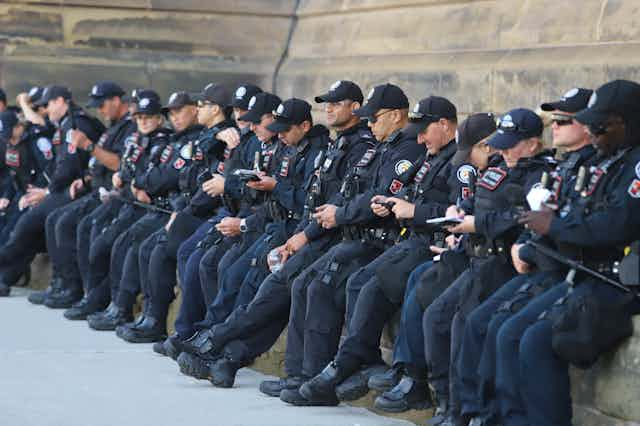Year-end debates about 2024 budgets have already begun across Canada, with cities like Waterloo and Ottawa proposing spikes in police budgets.
Despite public calls to “defund the police” in 2020, the budgets of Canadian police departments have continued to rise. In fact, when it comes to public safety budgets in Canada, the last five years have seen increasing investments in policing and under-investment in the social services and programs that contribute to safer cities.
The continued over-investment in policing is a limited and contradictory approach to safety. For one thing, police forces don’t address the root causes of violence and other harms.
Research has shown the “deterrence effect” of policing to be weak, while aggressive policing often impairs the social relations and institutions that normally keep violence and conflict in check.
It should be obvious that preventing violence and other harms is better than punishing perpetrators after the fact. However, as numerous studies have shown, this requires an investment in a range of non-police services and programs. It means recognizing the inherent limitations of policing and adopting a broader approach to public safety.
Too often, however, city leaders equate safety with policing, and throw public money at an institution that actually creates unsafety for many people while failing to prevent violence and other harms.

Contradictions in policing
Policing is also a contradictory approach to safety.
While promising safety to some, policing is a source of “unsafety” for many communities. This is evident in police carding and violence against Black people, the brutal repression of Indigenous people and especially land defenders, the harassment of unhoused people and the destruction of their property, the killing of people experiencing mental health crises, the criminalization of sex work and much more.
This is nothing new. Police forces were created specifically to enforce a particular, white and bourgeois sense of order and safety, and police “reforms” like multicultural training and hiring more racialized police officers do not alter that core mission.
Various studies and reports since 2020 have provided further evidence of anti-Black racism in police stops and use of force, but none of this has stopped city leaders from further investing in the institution that causes these harms.
Read more: State of Georgia using extreme legal measures to quell ‘Cop City’ dissenters
If we view the police only as a source of safety, we are occupying a particular social position: a position of racial and class privilege.

Policing spending: Before and after 2020
In the spring of 2020, when the police killed Breonna Taylor in Louisville, Ky., George Floyd in Minneapolis and Chantel Moore in Edmundston, N.B., new attention was brought to the contradictions and limitations of policing.
Historic protests filled the streets in the United States and around the world. The phrases “Black Lives Matter” and “Defund the Police” became synonymous.
The rhetoric of defunding the police may have been new, but the core demand was consistent with longstanding critiques of policing and racial injustice. The core demand, as Black feminist scholar and organizer Robyn Maynard explains, is to reallocate funding, power, equipment and force “away from agents of state violence and repression, and committing to invest instead in community-centred forms of safety.”
However, police budgets have continued to increase by an average of three per cent per year, adding to an almost 20 per cent increase over five years. Budgets for 2023 saw an especially large increase: an average of six per cent, with increases of more than eight per cent in Montréal, Vancouver and Peel Region.

Therefore, the 2020 protests had little impact on police budgets in Canada. In fact, police spending actually increased at a greater rate in the three years after 2020 than in the three years before it. In some cities, the change was especially significant. Montréal’s budget, for example, increased by 19 per cent after 2020.

As always, police spending is determined not just by what cities decide to provide, but what police forces themselves decide to spend. Police forces generally adhere to their budgets, but there are exceptions.
Between 2018 and 2022, Ottawa and Vancouver exceeded their budgets by $8.7 million and $12.2 million, respectively. The glaring outlier is the Montréal police, which exceeded its budget by $35.7 million per year and $178.6 million overall.

Choosing safety, not policing
The political message these budget choices sends is clear. Whatever statements city leaders might have made in 2020, Black lives do not matter to them in practice.
More broadly, cities have failed to incorporate the key argument that progressives have always made, reinforced in 2020: services and programs other than policing are required to prevent violence and other harms.
There have been some moves in this direction. Both Toronto and Edmonton have introduced crisis response teams that see health workers, rather than police, respond to calls related to mental health. Ottawa will follow suit next year.

The amount invested in these teams, however, is much less than the new money provided to police.
As the end of 2023 approaches, Canadian urban leaders need to recognize that the safety of their cities means investing in safety, not police.
There is no shortage of guidance for this shift, from Mariame Kaba and Andrea Ritchie’s book No More Police to the excellent report by Halifax Board of the Police Commissioner’s Subcommittee and the alternative city budget from the Montréal Defund the Police Coalition.
The broad imperative is to significantly reduce police budgets for 2024, while reallocating funding to some of the many services and programs that give people more safety and police less work to do.

